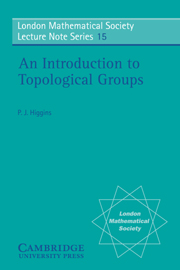CHAPTER I - Preliminaries
Published online by Cambridge University Press: 05 June 2013
Summary
Historical notes
Abstract topological groups were first defined by Schreier in 1926, though the idea was implicit in much earlier work on continuous groups of transformations. The subject has its origins in Klein's programme (1872) to study geometries through the transformation groups associated with them, and in Lie's theory of continuous groups arising from the solution of differential equations. The ‘classical groups’ of geometry (general linear groups, unitary groups, symplectic groups, etc.) are in fact Lie groups, that is, they are analytic manifolds and their group operations are analytic functions. On the other hand, Killing and Cartan showed (1890) that all simple Lie groups are classical groups, apart from a finite number of exceptional groups.
In 1900 Hilbert posed the problem (No. 5 of his famous list) whether every continuous group of transformations of a finite-dimensional real or complex space is a Lie group. The twentieth-century habit of axiomatising everything led to a more abstract formulation of this problem. A topological group is a topological space which is a group with continuous group operations, and the question is: What topological conditions on a topological group will ensure that it has an analytic structure which makes it a Lie group? Since integration was a major tool in the study of Lie groups, especially their representations, it became important to establish the existence of appropriate integrals on general classes of topological groups.
- Type
- Chapter
- Information
- An Introduction to Topological Groups , pp. 1 - 15Publisher: Cambridge University PressPrint publication year: 1975



